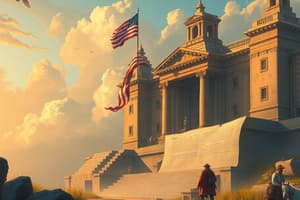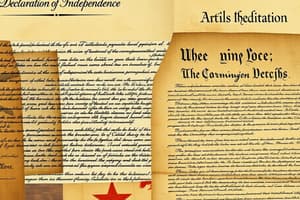Podcast
Questions and Answers
To whom was the declaration addressed to?
To whom was the declaration addressed to?
- British people
- American people (correct)
- British government
What were the goals of this declaration? (to get them inspired)
What were the goals of this declaration? (to get them inspired)
- Declare independence from the British Empire (correct)
- Able to declare war, make peace, alliances and trade deals (correct)
- Foundation of the United States of America (correct)
What reasons were given for writing the declaration?
What reasons were given for writing the declaration?
- The colonists tried to tell their British brothers / the British King that they needed a change, but nothing happened (correct)
- Every man is created equal: he has the right to life, liberty and the pursuit of happiness (correct)
- If government is abusive, the citizens / people have the right to abolish it (correct)
Explain and assess the main principles of the US constitution.
Explain and assess the main principles of the US constitution.
How does the check and balance operate in the US constitution?
How does the check and balance operate in the US constitution?
Name several characteristics of the slave system in the American South.
Name several characteristics of the slave system in the American South.
Why did Abraham Lincoln signed the Emancipation Proclamation.
Why did Abraham Lincoln signed the Emancipation Proclamation.
Discuss different causes of the American Civil War.
Discuss different causes of the American Civil War.
Put different events from American history in chronological order.
Put different events from American history in chronological order.
Explain the most important terms from Marxist theory.
Explain the most important terms from Marxist theory.
Flashcards
Declaration of Independence
Declaration of Independence
A document declaring the 13 American colonies' independence from British rule, justifying the need for separation and establishing the foundation of the United States.
Goals of the Declaration
Goals of the Declaration
To declare independence, lay the groundwork for the US, and assert the right to engage in international affairs (war, peace, alliances, trade).
Reasons for the Declaration
Reasons for the Declaration
It condemned British abuse of power, sought to inform the King of needed changes, and advocated for equality for all men.
Separation of Powers
Separation of Powers
Signup and view all the flashcards
Checks and Balances
Checks and Balances
Signup and view all the flashcards
President's Power
President's Power
Signup and view all the flashcards
Congress's Power
Congress's Power
Signup and view all the flashcards
Supreme Court's Power
Supreme Court's Power
Signup and view all the flashcards
Presidential Veto
Presidential Veto
Signup and view all the flashcards
Impeachment
Impeachment
Signup and view all the flashcards
Slavery in the South
Slavery in the South
Signup and view all the flashcards
Emancipation Proclamation
Emancipation Proclamation
Signup and view all the flashcards
Reasons for the Emancipation Proclamation
Reasons for the Emancipation Proclamation
Signup and view all the flashcards
American Civil War
American Civil War
Signup and view all the flashcards
Differences between North and South
Differences between North and South
Signup and view all the flashcards
Proletariat
Proletariat
Signup and view all the flashcards
Surplus Value
Surplus Value
Signup and view all the flashcards
Capitalism
Capitalism
Signup and view all the flashcards
Communism
Communism
Signup and view all the flashcards
Proletariat and Bourgeoisie Conflict
Proletariat and Bourgeoisie Conflict
Signup and view all the flashcards
Alienation
Alienation
Signup and view all the flashcards
Abolition of Bourgeois Property
Abolition of Bourgeois Property
Signup and view all the flashcards
Classless Society
Classless Society
Signup and view all the flashcards
Study Notes
Declaration of Independence
- Addressed to British government, British people, and American people, and others to inspire them.
- Goals were to declare independence from the British Empire, found the United States of America, and be able to declare war, make peace, forge alliances and trade deals.
- Reasons included government abuse, colonists' need for change, and the idea of equality, life, liberty, and the pursuit of happiness.
US Constitution
- Separation of Powers: A powerful President overseeing armed forces, checks and balances.
- Checks and Balances: President can veto legislation, appoint Supreme Court judges, Presidents can be impeached, Congress can override presidential vetoes.
- Judicial Review: Supreme Court can rule laws/presidential actions as unconstitutional.
American Slave System
- Characterized by a mix of affection, feelings of superiority, cruelty, and violence towards slaves, which included excessive violence and torture.
- Slaves frequently ran away to Northern states or Canada
- Rape of female slaves was frequent
- Children of slaves were also forced into slave labor.
Emancipation Proclamation
- Lincoln signed the Emancipation Proclamation to save the Union.
- Former slaves could join the Union army.
- The move gave the Union a moral cause to fight for.
- It was to prevent other countries to join Southern states' side.
American Civil War Causes
- Differences: Significant differences existed between Northern and Southern states.
- North: No or little slave labor; industrialized; working class; many immigrants; wanted protection through tariffs.
- South: Agriculture (cotton, tobacco, rice); slave labor; wanted open trade.
US History Chronological Order
- 1607: Jamestown founded
- 1776: Declaration of Independence
- 1787: US Constitution adopted
- 1861-1865: Civil War
- 1863: Emancipation Proclamation
Marxist Theory
- Capitalist Mode of Production: Proletarians (workers) sell their labor to survive, creating surplus value for capitalists. This creates class struggle.
- International Scope: Communism requires a global movement.
- Class Struggle: Proletariat and Bourgeoisie clash with conflicting interests in capitalism.
- Alienation: Capitalism alienates workers from their labor and the product they produce.
- Abolishing Bourgeois Property: Revolution aims for an end to private property.
- Classless Society: A result of the proletarian revolution; land, industry, labor, and wealth are shared.
Studying That Suits You
Use AI to generate personalized quizzes and flashcards to suit your learning preferences.




